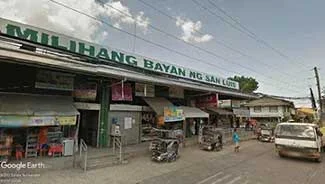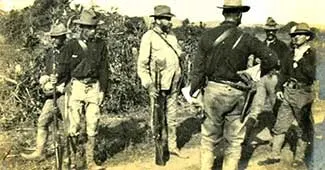San Luis, Batangas: Historic and Folkloric Notes about some of its Barrios
This article is part of a series of articles dedicated to resurrecting otherwise forgotten historic and folkloric trivia about the barrios of the Province of Batangas. The information contained in the series is taken from documents required by the Presidency of Elpidio Quirino in 1951 of all Department of Education districts around the country to help reconstruct the country’s history. These documents are filed at the National Library of the Philippines Digital Collections.
This time, we feature the barrios of the Municipality of San Luis. The town is fortunate in that almost all its barrios are represented. Only the barrios of Balite, Dulangan, Manggahan and Tejero are not included. It is possible that no documents were submitted for these barrios or, if there were, these had been eroded by time.
Abiacao
According to folklore, early during the Philippine Revolution, natives of the barrio fled when Spanish soldiers arrived to make camp. Believing that the place was safe, the soldiers deposited their food and ammunitions in one of the ravines that bordered the barrio. When some of the natives returned, they stole the “abiyo,” which was supposed to have meant food supply. From then on, the place became known as “Abiyocaw,” the appended suffix “caw” supposed to have been from the Tagalog word “nakaw” or stolen. The name would later change to “Abiakaw” and still later its present Abiacao. The barrio’s original settlers were the Gonzales and Macatangay families.
Source: History and Cultural Life of the Barrio of Abiacao
Bagong Tubig
This barrio’s name was supposed to have been given because of a spring near the foot of a hill, the waters of which fed into a stream that ran through the middle of the barrio. Its original inhabitants were the Jerez, Alcaraz and Huerto families. In World War II, Japanese soldiers under the command of one Captain Sato encamped in the barrio. They forced inhabitants of the barrio to dig tunnels which served as their hideouts and storage for their ammunitions. Later, American forces trying to liberate Batangas shelled the Japanese camp in the barrio from Lemery, causing houses to burn. Before retreating, the Japanese committed atrocities in the barrio and killed two locals named Agapito Lastimosa and Leon Patolot.
Source: History and Cultural Life of the Barrio of Bagong Tubig
Balagtasin
Balagtasin’s name was supposed to have been given because of an old road that ran through it which connected barrios to the north with the ones to the south. Its original families were the Gonsalbo, Carandang, Hernandez, Moresca and Cortez families. During the Philippine-American War, there was an encounter in a nearby hill between American soldiers and Filipino forces under one Lieutenant Mariano Aseron. The Filipinos were defeated. After the war, rinderpest1 killed scores of cattle in Balagtasin and neighboring barrios. During the Japanese occupation, because of food shortages everywhere, inhabitants of the barrio turned to eating corn, cassava and other root crops to survive. Frequently, Japanese Kenpetai2 soldiers visited the barrio to take the locals’ chickens and eggs.
Source: History and Cultural Life of the Barrio of Balagtasin
Banoyo
The name of this barrio was supposed to have been taken from the name of a bird which abounded in the place when there were still trees aplenty in it. The barrio’s original families were the Mendozas, Villanuevas and Napeñas. Early during the American regime, the house of one Aquilino Badillo served as the barrio’s first school building. Mr. Amando Ilagan was the barrio’s first schoolteacher. At one time, Banoyo was also referred to as “Palengke” because of its market, where many merchants from Taal went to sell their goods. During the Japanese occupation, inhabitants of the barrio were forced to evacuate as the Japanese soldiers arrived and occupied their houses.
Source: History and Cultural Life of the Barrio of Banoyo
Boboy
This barrio was named after the kapok tree3, alternatively called “boboy.” The Mendozas and the Castillos were the barrio’s original families. In World War II, Japanese soldiers occupied the eastern part of the barrio for three years. Locals were forced to dig tunnels which would serve as storage for the Japanese. Later, prime commodities and valuables were seized from the barrio’s inhabitants, who were forced to take these to the tunnels. Local farmers were compelled to plant cotton and not allowed to plant their own crops. In the absence of food, people turned to eating cassava to survive. When the Americans arrived and had started to chase off Japanese troops, a guerrilla command under one Orlando Diokno killed a Japanese soldier in the western part of the barrio and buried him right where he was shot.
Source: History and Cultural Life of the Barrio of Boboy
 |
| Boboy was supposed to have been named after the kapok tree (above). Image credit: Alexander, Wikipedia. |
Bonlio (Bonliw)
This barrio was supposed to have been named after the bonliw tree (polyscias florosa4), which presumably once grew in abundance in the area. Bagong Tubig used to be a part of this barrio, which was first settled by the Hernandez family. During the latter part of the Spanish regime, inhabitants of the barrio who did not possess cedulas (residence certificates) went into hiding for fear of being taken to the town and punished. The barrio was also badly affected by a cholera epidemic. During the Philippine-American War, a clandestine bullet factor called a “mistranza” was put up in the barrio. The “maestro” who created the bullets was a Chinese mestizo named Juan Utangko, assisted by Pascual Ayson. In World War II, inhabitants of the barrio did not have to contend with food shortages but were used as slave labor by the Japanese.
Source: History and Cultural Life of the Barrio of Bonlio
Calumpang
This barrio was named after a kalumpang (wild almond5) tree that grew in the southern part of its territory. Its original inhabitants were the Aseron, Magsombol, Celindro, Bonsol and Maulion families. During the latter part of the Spanish regime, the barrio’s inhabitants were treated like slaves by the Spaniards, forcing many of the men to join the revolutionary forces. In World War II, the barrio’s inhabitants were forced by the Japanese to plant their fielids to cotton. Many men from the barrio joined the guerrilla movement. Ten Japanese soldiers were killed by these guerrillas in the barrio in 1945.
Source: History and Cultural Life of the Barrio of Calumpang
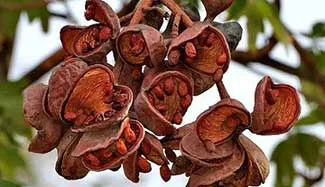 |
| Calumpang was named after the wild almond tree, the fruits of which are shown above. Image credit: Uplo, Wikipedia. |
Durungao
At the slope of a mountain near this barrio was a spring from which people fetched water. Whenever they ascended the mountain to do so, from above they could look beyond the spring towards the creek (“dinurungawan ang batis”). From this, the barrio obtained its name. Previously, the barrio was called Putol (literally, cut or has been cut). According to old folks in the barrio back in the fifties, Durungao was first established around 1703. Its original families were those of Jose Artillaga and Mariano “Cabuyao6.” During the Philippine-American war, Filipino freedom fighters under the command of Mariano Aseron, Gregorio Salazar and “Tenienteng” Tura set up headquarters in the barrio. In World War II, Japanese soldiers under the command of one Captain Murai set up camp in the barrio. Its inhabitants were used as slave labor in the fields to plant cotton. Three persons in the barrio were killed by the Japanese: a sugar technologist by the name of Lauro Catapang; the barrio lieutenant Martin Medina; and one Felix Apedra.
Source: History and Cultural Life of Durungao
Locloc
According to folklore, the barrio got its name from the Tagalog word “luklok,” meaning to sit down. The barrio being atop a hill, people who went there had to sit down and rest several times from fatigue. The first settlement in the barrio was built by one Paterno Villestas, his wife Maria and their children Martin, Juan, Esperdiona and Felipa. From them would descend the Salazar, Herndandez, de Villa, Onda and Diokno families of Locloc. During the Philippine-American War, houses in the barrio were burned and its inhabitants rounded up by the so-called Macabebe Scouts to live in a concentration camp in Banoyo. In World War II, Locloc was one of the few barrios whose inhabitants did not have to suffer the rigors of war.
Source: History and Cultural Life of the Barrio of Locloc
Luya
This barrio was named after the ginger, although none of the barrio folks back in the fifties could explain why. Its original settlers were the de Villa, Corales and Badillo families. During the Spanish occupation, people from Taal and Lemery evacuated to this barrio. (The document failed to explain why, but we can conjecture that this was probably to avoid persecution by the Spanish Civil Guard.) During the Philippine-American War, inhabitants of the barrio were abused and rounded up by the Macabebe Scouts to live in a concentration camp in Banoyo7. In World War II, this barrio was also relatively spared from the horrors of war.
Source: History and Cultural Life of Luya
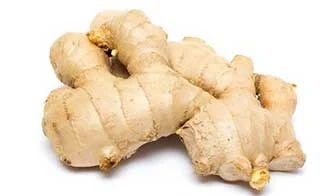 |
| Needless to say, Luya was named after ginger, which must have grown aplenty in the barrio. Image credit: Kalusugan.ph. |
Mahabang Parang
This barrio used to have a big territory, especially when the sitio Munting Pook still belonged to it. This was why it was so named, Mahabang Parang meaning a long field or prairie. The barrio’s original settlers were the families of Juan Mendoza, Andres Yuzon, Telesforo Yuzon, Gregorio Marasigan, Ramon Palamiano, Vicente Salingag, Leodovico “Bikoy,” Pedro de Villa, Benito Caringal, Tomasino de Castro and Epifanio Yuzon. During the Spanish era, cattle rustling was a common crime committed in the barrio. During the Philippine-American War, many of the men in the barrio joined Filipino freedom fighters in their efforts to keep the Philippines independent of American hegemony.
Source: History and Cultural Life of the Barrio of Mahabang Parang
Mozon (Muzon)
Mozon used to be named San Luis and was a barrio under Taal. When San Luis was formally created as a municipality, Mozon8 was given a new name which signified that it was at the junction of three towns – San Luis, Alitagtag and Taal. Its original families were the Sanggalangs, Bernaleses, Deleases, Martinezes, Andals and Marasigans. In World War II, Japanese soldiers who came to the barrio seized food like rice, corn and sweet potato along with the barrio folks’ horses, goats, cows and chickens. Like in other barrios, the locals were also used by the Japanese as slave labor in the fields and ordered to plant cotton. When news broke that General Douglas McArthur’s forces had landed in the country, the Japanese burned houses in the barrio and killed some of its inhabitants. It was said that of all the barrios of San Luis, Mozon was the one the suffered the greatest damage in terms of properties destroyed and lives lost.
Source: History and Cultural Life of the Barrio of Mozon
Pacifico
This barrio was established just when Spanish rule over the Philippines was about to end. It used to be part of Sampa and took the new name Pacifico after the former was divided into two. Nobody in the fifties knew why. During the Japanese occupation, children of the barrio stayed at home rather than attend school, primarily because the medium of instruction had been changed from English to Nihongo. Young men also fled to the mountains and took up arms, presumably joining guerrilla groups. The Japanese commandeered rather than destroyed buildings in the barrio for their own use, while at the same time confiscating the locals’ food produce and farm animals.
Source: History and Cultural Life of the Barrio of Pacifico
Sampa
This barrio was so named because of the inclined road that led to it, which gave people traveling the road a hard time. Directly translated, the barrio’s name means to ascend or get on top of. The barrio’s original families were those of Eleuterio de Villa, Joseph de Villa, Juan Aquino, Rosa Ilagan, Apolinario Clor, Manuel Cataquez and Juan Tordicilla. During the Japanese occupation, life in Sampa pretty much went the same way as that in its former sitio Pacifico: the decline in enrolment, the commandeering of houses, the confiscation of food and the planting of the fields to cotton instead of the usual food crops needed for survival.
Source: History and Cultural Life of the Barrio of Sampa
 |
| The plantation of rice was neglected in many barrios because the Japanese forced farmers to tend to cotton fields instead. Image credit: Agricultural Farming. |
San Antonio
This barrio also used to be part of Sampa. It was named San Antonio supposedly after one Antonio Cabrera, one of the oldest men in the barrio. (This explanation from the source document probably needs to be taken with a grain of salt, as it does not explain the “San” which in Spanish means saint.) The original settlers of the barrio were the Cabrera, Mendoza, Segunial and Rodriguez families. As in other barrios in San Luis, in World War II the people of this barrio were used as slave labor in cotton fields and forced to neglect the plantation of food crops. Houses and animals were also commandeered by the Japanese.
Source: History and Cultural Life of the Barrio of San Antonio
San Isidro
This barrio was named after the patron saint of the municipality. Its old name was Mulawin, after the molave tree9. This barrio used to be but a sitio of Taal. The barrio was supposed to have been originally settled by the family of one Pastor Cortez. In the old days, the barrio used to be composed of the sitios of Gulod and Labac.
Source: History and Cultural Life of Barrio San Isidro
San Jose
San Jose was once part of the big barrio of Tungal. Its date of establishment is unknown. It had two sitios called Labak and Ibabaw. The barrio’s earliest settlers were the Siscar, Bonsol and Cornejo families. During the Philippine Revolution, members of the Katipunan, headed by one. Lt. Bernardo Magsino, camped in a place called Looban in the barrio’s northern part. During the American era, a school that taught in Tagalog was opened in the barrio under a teacher called “Maestrong Jacinto.” San Jose was reasonably left undisturbed by the Japanese in World War II.
Source: History and Cultural Life of the Barrio of San Jose
San Martin
This barrio was named after the patron saint of Taal, Saint Martin of Tours. When the barrio was formally constituted, a road was built that would link its three sitios. The original families in these sitios were: Hernandez and Maulion families in Sitio Bagong Karsada; Hernandez and Malapitan families in Sitio Manggahan; and the Cipres family in Sitio Puguan. In World War II, Japanese soldiers used the big houses in San Martin as their quarters. Manpower from the village was utilized as slave labor by the Japanese as they constructed roads, tunnels, foxholes and fortifications.
Source: History and Cultural Life of the Barrio San Martin
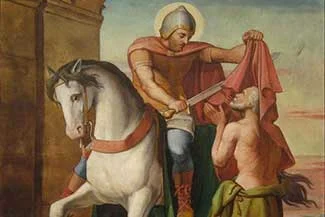 |
| San Martin was named after St. Martin of Tours, patron of Taal. Image credit: Integrated Daily Catholic Life. |
Santa Monica
This barrio was supposed to have been named after a religious old woman named Monica whom barrio folks fondly called “santa.” It had two sitios called Puera and Mayahan. The barrio was first settled by the Hernandez family. They were supposed to have been kind and hospitable to newcomers that soon other families moved to the place. In 1898, the barrio was the hideout of the so-called “insurrectos,” as both the Spaniards and Americans called the Filipino freedom fighters. In World War II, when the Japanese soldiers arrived, they used the school as their quarters, burning the desks inside the rooms when they cooked their food. As elsewhere in San Luis, the soldiers used locals as slave labor. Inhabitants of the barrio were so afraid to leave their homes in fear of Japanese atrocities that they turned to weaving sinamay cloths as a form of livelihood. After liberation, many of the barrio’s inhabitants converted to the Iglesia ni Kristo.
Source: History and Cultural Life of the Barrio of Santa Monica
Taliba
This barrio used to be called Halang. It had to be given a new name when San Luis became part of Taal in 1904. The latter already had a barrio with the same name. To avoid confusion, Halang in San Luis was renamed Taliba, which was supposed to mean that it was guarding against Barrio Talon from jumping and Barrio Sampa from climbing 😵. Taliba’s original settlers were the Atienza, Cabello, Lasala, Siscar and Marasigan families. During the Philippine Revolution, members of the Katipunan engaged the Spaniards in a place called Hilerang Kawayan. During the Philippine-American War, poorly equipped Filipino forces came up against the United States Army in the barrio but were forced to retreat. Before the outbreak of World War II, USAFFE troops were stationed in Taliba, but were relocated after the bombing of Pearl Harbor.
Source: History and Cultural Life of the Barrio of Taliba
Talon
This barrio was established towards the latter end of the Spanish regime. Its jurisdiction included the barrio proper and a sitio called Bangas. The barrio used to be part of Taliba and its earliest settlers were the Hernandez, de Villa, Marco, Masangkay and Carable families. Its name was likely given because people travelling from Taliba to the barrio needed to jump over a ravine to get from one side to the other.
Source: History and Cultural Life of the Barrio of Talon
Tungal
Tungal was supposed to have been named after a flower called katunggal10, the northern Christmas Lily, which presumably grew abundantly in the barrio. It used to be a larger barrio which included the barrio of San Jose. Tungal’s original settlers were the Castro, Cornejo and Bonsol families along with that of one Capitan Andong. During the Philippine-American War, inhabitants of the barrio were forced to live in concentration camps. During the Japanese occupation, locals were forced to plant cotton in the fields, thus neglecting the rice farms.
Source: History and Cultural Life of the Barrio of Tungal
2 “Kenpetai” was the Japanese Military Police in World War II, Wikipedia.
3 “Ceiba pentandra,” Wikipedia..
4 “Bonliw and Laneteng Gubat,” online at DENR.
5 “Kalumpang,” online at Philippine Medicinal Plants.
6 It appears from the quotation marks in the source document that Cabuyao was a moniker.
9 “Vitex parviflora,” Wikipedia.
10 “Proiphys amboinensis,” Wikipedia.

